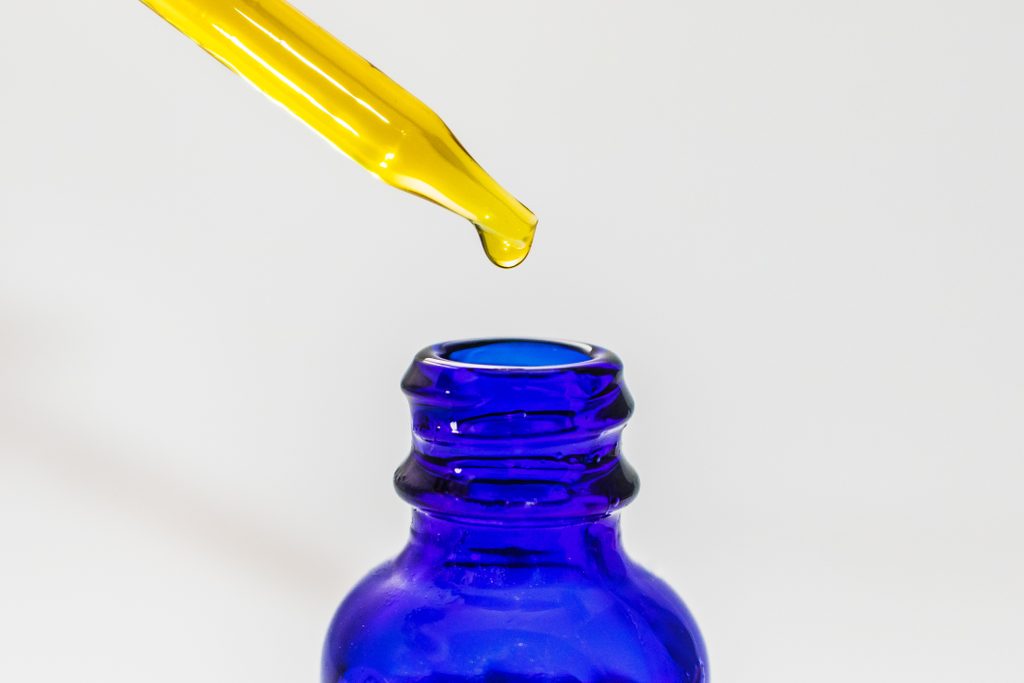Why I’m Convinced CBD Drops Helped My Dogs Live Longer
Updated: Dec. 14, 2023

When our dogs experienced some serious health issues, a few drops of CBD changed everything.
I have always had dogs, and I like to think that all of them lived (and live) great and healthy lives. They only eat organic pet food, get plenty of exercise, and see the vet annually. And while that’s certainly contributed to their longevity, there’s something else that I believe has helped. In 2012, we began giving daily CBD drops to Malibu, our 110-pound Golden Retriever, and Grandma, our 15-pound Shih Tzu. They were both 10 years old at the time.
We started giving the drops to Malibu after he was hit by a car. We rushed him to the vet, where he was treated for his injuries, but even after he’d technically healed, he was still experiencing an immense amount of hip pain and arthritis. At first, we were hesitant to give Malibu the CBD because there wasn’t much information on it at that time and we weren’t sure if CBD was safe for dogs. But we didn’t want him on pain medications for the rest of his life, so we ultimately decided to give it a try.
It was the best decision we ever made. After just one day of taking CBD, Malibu seemed much more mobile and in less pain. After a week, he was running around and acting like his old puppy self. Since we had such positive results with Malibu, we started giving CBD to Grandma. She, too, became much more active and playful. They took CBD for the rest of their long lives—Malibu lived to be 16, and Grandma lived to 18.
Did you know that CBD may help perk up your older pet? Find out CBD can help relieve your pets of pain, arthritis & anxiety inside the all-new book, The Essential Guide to CBD.
What is CBD?
When you hear the term CBD, there’s a good chance you immediately think of marijuana or cannabis. Of course, there’s a reason for that, but there’s a big difference between CBD and marijuana. According to the FDA, “CBD is a single compound in the cannabis plant, and marijuana is a type of cannabis plant or plant material that contains many naturally occurring compounds, including CBD and THC.” THC is the component that gives you the “high” associated with marijuana, while CBD has been shown to promote well-being and health in both people and animals. If you’re taking true CBD, there should be no high. Here are some more CBD facts you should know before trying it.
How can it help your dog?
There is still much to be learned about how CBD can aid in health and longevity in dogs. However, early studies have shown promising results. In a joint study conducted by Baylor College of Medicine and Medterra CBD, researchers found that liposomal CBD was safe and that it improved the quality of life for dogs diagnosed with osteoarthritis. “Osteoarthritis is a chronic, long-term, damaging condition, and pretty much every dog that took an appropriate dose of CBD saw significant benefits within a month,” says Matthew Halpert, PhD, research faculty at Baylor College of Medicine and one of the study’s authors. “CBD was reducing the inflammation and allowing genuine healing and improvement.”
Still, research on CBD for dogs is still in its early phases. “What we know about CBD to date suggests there may be clinical value, so we’re excited about that potential,” says Douglas Kratt, DVM, president of the American Veterinary Medical Association (AVMA). “However, we have several concerns.” Many vets don’t feel comfortable recommending CBD because there’s been minimal research, and since it’s not FDA-approved, they are unable to prescribe it as medication.
While our vet never told us to give our dogs CBD (we decided to give it to them on our own), he was very surprised by its effects. He believed that it helped them remain active and mobile in their older years, as well as reduced arthritis-related inflammation and pain in both dogs.

What is the correct dosage?
CBD dosage depends on the size of your dog. Bigger dogs may need more, while smaller dogs may need less. In the Baylor and Medterra study, researchers found that the 20-milligram dosage of CBD didn’t have much of an impact on the large dogs; however, the higher dosage of 50 milligrams yielded positive results. Halpert recommends starting your dog off on about 20 milligrams a day for a week. See how your dog responds and then slowly increase the dosage if necessary.
It’s also important to know that you can give too much CBD to your dog, although there aren’t major adverse side effects. But regardless, more CBD won’t yield better results. The bottom line: If you’re seeing positive results with the dosage, there’s no need to give your dog more. We gave Malibu and Grandma CBD oil every morning by mixing it into their food. Since Grandma was smaller, she received 40 milligrams, while Malibu received 75.
How is CBD administered?
CBD products come in various forms like edibles, creams, and oils. Think of CBD products as either consumption (foods) or topical (creams). Halpert says that topical CBD is better for a local effect. For example, say your pup has a sore knee or hip. A topical cream applied directly to the area might work best. If you’re looking for an overall effect—like if your pup is older and achy everywhere—you’d want to go with a consumable product like a treat or oil. Since both of our pups were old and experiencing pain all over, we gave them the CBD oil. We didn’t try any other CBD products since we were happy with the CBD oil results. Speaking of consumable products, check out these cancer-fighting foods for dogs.
What are the possible health risks?
A huge problem with CBD for dogs is that it’s not approved or regulated by the FDA, so quality is a major concern. Multiple studies have shown that many CBD products did not contain the concentrations listed on their labels—and some didn’t contain any CBD concentrations at all. Other products were found to be contaminated and dirty. “Without proper oversight and quality control, pet owners may not be getting what they think they’re getting,” says Dr. Kratt. “This could have dangerous consequences for our pets.” Make sure you know the signs that a CBD product might be fake, whether it’s for you or your pup.
Something else to keep in mind: There are always some health risks involved when giving your dog a new medication, food, or product. “You want to be careful if your dog is on other drugs,” says Halpert, as adverse reactions like drowsiness and liver injury, although unlikely, can occur. Plus, since CBD for dogs is very new, more research still needs to be done to understand the full health risks and benefits.
Where do you get it?
Since there’s no FDA regulation of CBD, where and how you get the product really matters. It’s essential to do your homework before giving your dog anything. “Find a reputable company that does testing because you don’t know what you’re getting with most of the products out there,” says Halpert. He also recommends getting a liposomal CBD, which he believes is safest and most effective. Liposomal CBD is created differently than regular CBD and has been shown to be more easily absorbable. It’s also worth talking to your vet to see if they have any recommendations. While they can’t technically prescribe CBD, some will point you in the right direction. If you’re not quite ready to take the CBD plunge, you can give your dog these things for pain.
Sources:
- FDA: “What You Need to Know (And What We’re Working to Find Out) About Products Containing Cannabis or Cannabis-derived Compounds, Including CBD”
- Pain: “A randomized, double-blind, placebo-controlled study of daily cannabidiol for the treatment of canine osteoarthritis pain”
- Matthew Halpert, PhD, research faculty at Baylor College of Medicine
- Douglas Kratt, DVM, president of the American Veterinary Medical Association